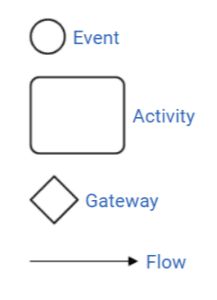What is BPMN and why is it helpful?

By Brenna Lofquist, Senior Marketing Consultant / Client Services Operations at Heinz Marketing
BPMN, if you haven’t heard of it, stands for Business Process Model and Notation. Direct from the BPMN website, it’s a standard that provides businesses with the capability of understanding their business procedures in a graphical notation and gives organizations the ability to communicate these procedures in a standard manner. BPMN can be used for a number of things and gets pretty detailed, it depends on your business’ needs and where BPMN can help. You can even obtain a BPM certification if you want to take it there.
For Heinz Marketing, BPMN comes in handy when we are creating visual workflows or diagrams for clients, so that will be the focus for this post. We’ll talk about why BPMN is important, our particular use case, and examples. If you want to dive deeper into BPMN, you can check out the website: https://www.bpmn.org/
What is BPMN?
We’ve already talked about the definition so lets get into the basics. As I mentioned before, there’s a lot more to it but the basics cover what we need when it comes to the work we do.
The four basic components of BPMN are:
- Event: Signifies a step in the process that requires action
- For example: A deliverable that needs review
- Activity: A step in the process/flow that should be completed or performed
- In most cases, Activity elements will be used most often
- For example: Schedule alignment meeting with sales and marketing
- Gateway: A visualization of divergence or convergence of the flow
- Example: If approval is required then there would be a branch for “yes” or “no”, where each branch would have it’s own set up steps
- Flow: A directional connector between elements in a process or flow. To put it simply, an arrow
- Lane (not included in screenshot above): A partition that is used to organize and categorize activities
- For example: If there are multiple roles/functions involved in a process, you might use lanes to show how the activities are different by role however, they relate to the overall process
One thing to note, these definitions aren’t directly from BPMN and have been adapted for our use. You’ll notice the definitions in the BPMN guide are a little technical and need to be interpreted. These are definitions we’ve agreed upon internally and will work from whenever we’re creating visuals or workflows. The definitions still align with the notation guide and can be recognized by other organizations because the notation is widely used and recognized globally.
Why is BPMN important?
BPMN, as mentioned previously, is recognized globally therefore it’s recognized by other organizations and there’s a common understanding of what the activities mean when used in a visual workflow or diagram. This is important because everyone is working from the same set of rules and it requires no additional explanations when reviewing with a new organization or in our case, a client. If a client is unfamiliar with BPMN, there’s a resource we can point them to and because it’s widely used, we aren’t forcing them to learn a process specific to our organization – it’s one they can continue to use.
Another reason, taken from the BPMN website, mentions that the world of business processes has changed dramatically over the past few years. Processes can be coordinated from behind, within, and over organizations natural boundaries so now a business process spans multiple participants, teams, etc. and it can be complex. Until BPMN, there has not been a standard modeling technique developed that addresses these issues.
Who is BPMN targeted at?
BPMN is targeted at a high level for business users and at a lower level for process implementers. Business users should be able to easily read and understand a BPMN business process diagram. And process implementers should be able to enhance a business process diagram with further detail in order to represent the process in a physical implementation. In general, BPMN is targeted at anyone that needs to communicate business processes in a standardized manner.
An example of BPMN
Click on the screenshot to make it bigger.
The below example showcases all of the BPMN basics. The process outlined uses lanes to differentiate between the visual design/development and copy design/development flows as it pertains to the same content asset. Events are used to indicate the need for review and gateways are used to determine approval. Flow activities are used to connect the steps in the process and in some cases, change direction based on the branches from the gateways.

To best understand and use BPMN at Heinz Marketing, we have created an internal document for our teams to reference. This makes it a little easier than referencing the BPMN guide because we can customize the definitions and examples to our specific use case.







